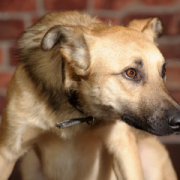July 23, 2024 –
Written by NOCO Humane’s Weld Campus Behavior Team: Kiyoka Tamesue, PSM, KPA-CTP and Julia Pinckney, MSc.
When your dog runs to greet you at the door, wiggly all over with a blissful smile from ear to ear, tail wagging, you just know they’re happy to see you, right? You also probably know something is wrong when you see a pup with a tucked tail and wide eyes. But, are you able to pick up on the subtler shifts in body language that lead up to those moments of powerful, overt emotion?
As the NOCO Humane Behavior Team, part of our job is to recognize and interpret subtle changes in body language that indicate potential shifts in an animal’s emotional state. Most animals don’t go from 0-10 in an instant; they usually begin with lower level signals to communicate their emotions long before escalating to snapping, snarling, fleeing, and/or hiding.
The trick is learning how to recognize and respond appropriately to the whispers in your animal’s behavior, and avoid contributing to their overstimulation to the point they need to scream.
(Interested in the secret language of cats? Stay tuned as that article will be released next month!)
Why is Understanding This Language Important?
The ability to decipher the body language of our beloved furry friends helps us to better understand their feelings, wants, and needs, which enhances our ability to care and provide for them. Additionally, recognizing animal behavior helps keep ourselves and the animals in our lives safe.
Picking up on an animal’s body language is especially important in a shelter setting, where animals frequently come in as strays and have no known behavioral history. Luckily for us, dogs each have their own communication style, and when we learn how to read and respond to their body language appropriately, we can better meet their needs, strengthen our relationships, and live in greater harmony together.
While each animal is an individual with their own unique behavioral quirks, there is a great deal of behavioral consistency within each species. By learning to read these commonalities in behavior and body language, we can better understand their inner emotional worlds and respond appropriately to what they are telling us.
A Holistic View
When observing and interpreting animal behavior, here are a few things to keep in mind:
- Look at the animal’s ENTIRE body
Looking at the position of an animal’s ears or tail can give you some important information, but it’s important to consider their entire body to get a full understanding of what they are communicating in the moment. - CONTEXT is key
Behavior does not occur in a vacuum, and the same behaviors can have VERY different meanings in different situations. Carefully observing the CONTEXT in which behaviors occur can help you gain a better understanding of what an animal is trying to tell you and why.
- Every animal is an INDIVIDUAL
An animal’s behavior is affected by many different factors that can vary widely from individual to individual. Learning their history, level of socialization, health status, breed, age, and genetics are just a few examples of variables that can affect how an animal behaves in a given situation.
Green, Yellow, and Red Light Behaviors
As animal behavior professionals, we all too commonly hear the phrase “The dog or cat just attacked OUT OF NOWHERE!” While it can certainly seem like these behaviors come from “out of the blue,” animals rarely bypass milder warning signs and go straight to snapping, scratching, or biting. In the rare instances where animals truly show little to no warning before escalating, it is often because their lower lower level signals have been punished or outright ignored in the past.
Human communication is very similar; we may start by dropping subtle hints like looking away or making a face to express discomfort or displeasure or use our ‘inside voices’, to resolve a conflict. However, if we feel ignored or invalidated by the other person, we might escalate to more heated forms of communication like yelling and slamming doors to get our point across.
In the shelter, we frequently break behaviors into “green, yellow, and red light” categories. As with traffic lights, green means “good to go”, yellow means “use caution, slow down,” and red means “stop!” These “red light” behaviors almost always occur when an animal’s “yellow light” behaviors are ignored or go unrecognized.
Green and red light behaviors tend to be the easiest to recognize because they represent the “extremes” at either end of the behavior spectrum. For example: A dog with soft eyes, a loose wiggly body and open, relaxed mouth is showing ‘green light’ behaviors and indicating that he would like to continue the interaction. A dog who is making direct and hard eye contact, growling, baring teeth, and has her weight shifted forward is showing red light behaviors, which indicate that all interactions should be stopped.
A dog that is turning their head away, has a lowered body, a low tail, licking their lips, or even raising a front paw is showing yellow light behaviors. They are trying to tell you that they are nervous and need you to take a break or change your behavior so they can be more comfortable. The same thing goes for a cat who has moved away from you, has semi dilated pupils, and is starting to get tense.
Below are some common green, yellow, and red light behaviors. Examples of each are explained in more detail later in this article.
Green:
- Soft eyes
- Neutral pupils, not dilated
- Loose and wiggly body
- Indirect approach
- Attentiveness, approach, and seeking soft eye contact
- Frequently changing position
- Relaxed facial muscles, smooth forehead
- Slow blinks
- Helicopter or wide, sweeping tail wags
- Neutral or relaxed body, ears, and tail
- Play bows
- Body curved like a C
- Taking brief pauses during play (with other animals and humans)
- Bouncy, exaggerated movements
- Open and relaxed mouth (commissure pulled back, no wrinkles)
- Tongue lolling out
- Playful barking
- Normal panting
Yellow:
- Trembling
- Pacing
- Shaking off (stress relief)
- Exit seeking
- Displacement behaviors: Normal behaviors displayed out of context; intently sniffing ground, sneezing, yawning, lip licking, paw raise, shaking off as if wet. As mentioned above, depends on context of situation.
- Avoidance behaviors: backing away, turning head, hiding
- Hair standing on end (piloerection – this can also be a sign of arousal/excitement
- Weight shifted back
- Body/facial tension
- Tucked or low tail
- Tucked limbs
- Low body
- Tension around eyes, resulting in wide eyes or very tight and squinted eyes
- Fast and repetitive blinking
- Body tension
- Wide, round eyes
- Excessive drool (in abnormal context)
- Rapid panting (in abnormal context)
- Lip licking and tongue flicking
- Whale eye: sideways glance in which animal is avoiding direct eye contact and much of the white in their eyes is visible
- Dilated pupils
- Ears pinned back or flat against head
- Wrinkled forehead and facial tension
- Exposing belly (to surrender)
- Front paw raise
- Urinating
- Stress panting
- Low and fast tail wags
- Submissive smile or grin
Red:
- Fixed, direct, hard stare (eyes have cold, flat appearance)
- Rigid, frozen body
- Weight shifted forward
- Very dilated pupils
- Biting
- Wrinkled nose
- Mouth closes suddenly and tension around muzzle
- Piloerection: hair on shoulders, back, and/or base of tail stands on end (can also be a sign of excitement)
- Growling, snapping, snarling
- High/flagged tail with fast, lateral wags
- Puckered commissure (corners of mouth)
- Ears ridged and pointed forward
- Lips pulled up and back, exposing teeth
- Tail, spine, and head in a straight line
- Air snapping and head whipping
Dog Body Language
Greetings
We humans tend to greet dogs like we greet other people – frontally, making direct eye contact, often extending a hand, bending over, or leaning in to tussle the fur on the top of their head. Although this type of greeting feels ‘right’ to us, it’s a major faux ‘paw’ in even the most forgiving of dog circles. The ‘polite’ way to greet a dog (how well socialized dogs greet other canines) is to approach from the side with a curved, loose body, avoid direct eye contact, keep your eyes soft, and your hands/paws to yourself, unless the dog approaches and solicits pets.
What about hugs and kisses? They are simply out of the question! As much as we’d like to think our dogs love our hugs and kisses, the vast majority of dogs think it is the height of rudeness! Your own dog might tolerate an arm draped around their shoulder, or a face pressed against their own, but this is actually quite scary for many dogs and can make for a very unsafe situation. It is much more polite to approach a dog from the side, sit or kneel down, and to never lean or loom over them. Choice and control go a long way, let your furry friends come to you!
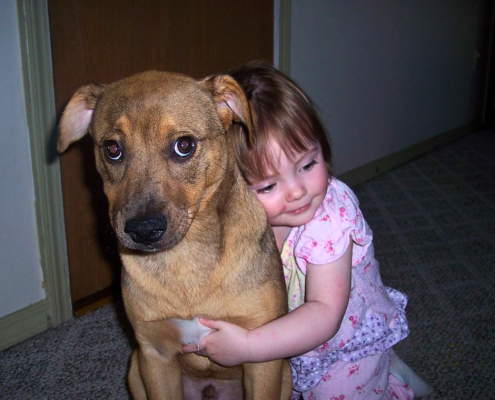
What appears to be a loving exchange between a little girl and her best dog friend, this dog appears uncomfortable. He is tense, has a closed mouth, whale eyes, and is leaning away from the hug.
Eyes
The shape, intensity, sheen, and direction of a dog’s gaze can tell you a lot about what they may be feeling.
Soft eyes: When a dog is content and at ease, their eyes often appear “soft” and relaxed. Soft eyes are commonly almond-shaped or slightly squinty and are not accompanied by tension in the surrounding skin or a furrowed brow. When a dog has soft eyes they may be feeling happy, peaceful, and relaxed. Can you identify at least 3 signs besides soft eyes that indicate the dogs pictured are content and relaxed?
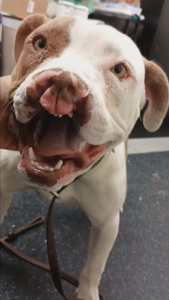
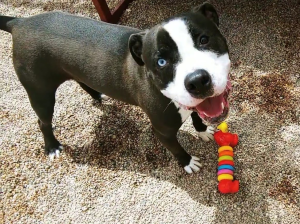
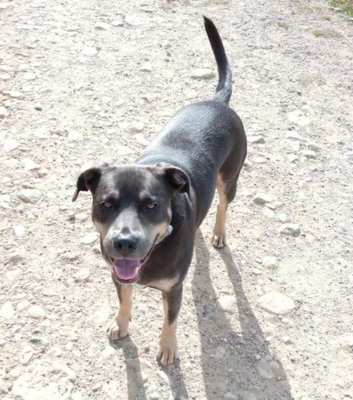
Soft eyes are often accompanied by relaxed or neutral ears, a loose and/or wiggly body posture, sweeping or circular tail wags, an open mouth, and/or lolling tongue – these are all examples of green light behaviors.
Round/Whale Eyes
Eyes that are round and wide open can often indicate that a dog is feeling frightened, stressed, anxious, conflicted, overwhelmed, or trapped. Dogs with wide, round eyes often have dilated pupils, bloodshot sclera (the white part of the eye), and the whites of their eyes showing. When a dog’s eyes are wide and the whites are showing, we call this “whale eye.”
Whale eye commonly occurs when a dog’s body and/or head are facing away from something that they are looking at (frequently a fear-inducing stimulus). Their eyes will be turned toward the object, but their body will be leaning or facing away from it.
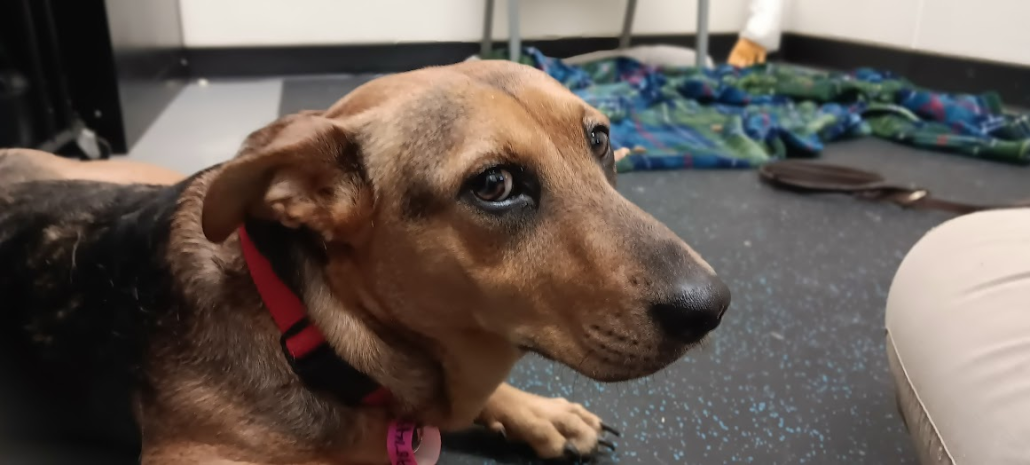
In the photo above, this dog is keeping a close eye on the person taking the photo, while simultaneously leaning her body away. This is an example of “whale eye.” She is also communicating her discomfort through body tension, backward facing ears, round eyes, and closed, tight mouth. Round wide eyes, whale eye, and side eye are often accompanied by dilated pupils, a tense and rigid body, pinned back ears, furrowed brows, lip licking, and a low or tucked tail. These are all examples of yellow light behaviors.
Pupils
Looking at an animal’s pupils can tell you something about their emotional state in many circumstances. Large pupils in a round, wide eye may indicate a high level of fear, anxiety, stress, and/or arousal. Smaller, “normal” sized pupils indicate a state of relaxation, contentment and/or comfort. Of course, as with all body language, context is key: is the environment light or dark? Is the environment noisy and active? What does the rest of their body look like?
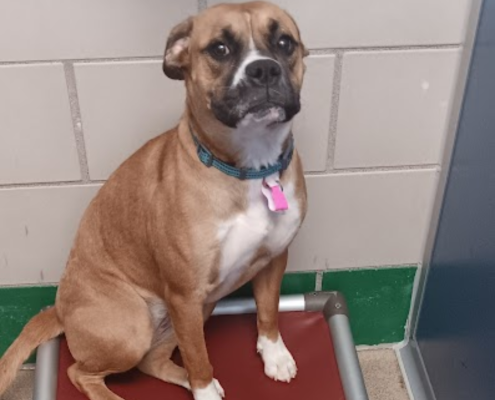
This dog has wide, round eyes with large pupil dilation, a furrowed brow, pinned ears, and a tense body.
Hard Stare
“Hard” eyes are intense and glassy and are accompanied by large pupil dilation, and significant facial and/or muzzle tension. Dogs who display hard eyes will often make direct, piercing eye contact with the person or animal they perceive as a threat. In the photo below, this dog’s body and facial muscles are very tense, he has a tightly closed mouth, his body weight is shifted forward, and his gaze is fixated on an object.
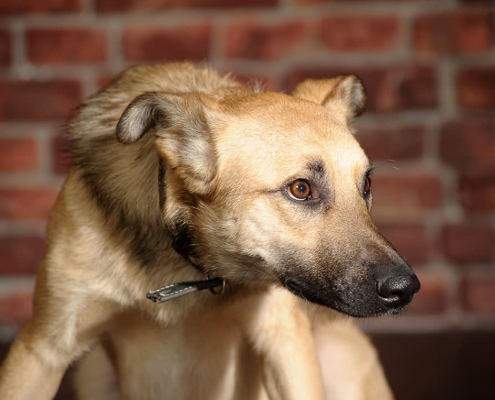
Hard eyes and stares are often accompanied by other signs of offensive aggression, such as body weight shifted forward, snarling, lunging, snapping, puckered commissure (corners of mouth), teeth baring, facial tension, and a flagged, stiff, fast-wagging tail. These behaviors often indicate a ready willingness to engage in biting, fighting, or other offensively aggressive behaviors if the dog is pushed further beyond their comfort zone or not left alone. These are examples of red light behaviors.
Body
Body posture, tension, alignment and weight distribution can give us a lot of important information about how a dog might be feeling. A dog whose body is loose and wiggly is usually happy and comfortable. Their bodies will often appear to be shaped like a “C” or an “S,” because their spine, head, and tail are misaligned.
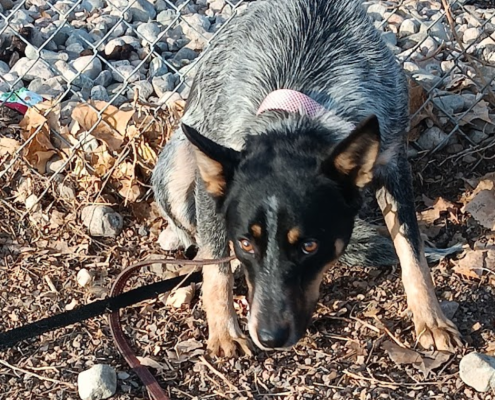
Dog’s body is tense and still. Her head is lowered toward the ground and her weight is shifted back.
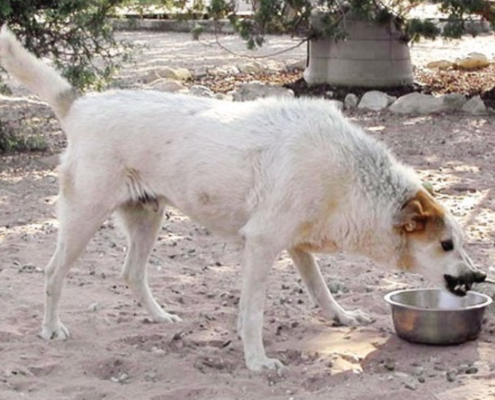
Dog has bared teeth, a tense, rigid, upright posture, piloerection, body weight shifted forward, and the spine, tail, and head are aligned (not relaxed).
A dog who is tense, frozen, and rigid is usually frightened or stressed, and may behave aggressively if they are forced to interact, and not given adequate space. Their bodies will often be in a rigid, straight line, with their head, spine and tail aligned. Fearful dogs frequently lower their heads or entire bodies to the ground and shift their weight onto their hind legs, while offensively aggressive dogs have a square, upright posture and shift their body weight forward. A dog who is frozen and stiff is giving clear red light signs of discomfort. If you see the behaviors described above, the best course of action is to give them space and leave them alone.
Tails
A common misconception about dog behavior is that a wagging tail is a happy tail. This couldn’t be further from the truth. Dogs wag their tails to express a plethora of emotions, including fear, happiness, confliction, appeasement, and aggression. Tails come in many different shapes and sizes, and are carried lower or higher naturally depending on breed and individual anatomy. Looking at the base of a dog’s tail (where the tail connects to the dog) will help you determine its position.
Helicopter or Sweeping Tail
We have probably all seen dogs whose tails spin in circles like a propeller or loosely sweep back and forth with such force that their rump or entire body looks like it’s wagging. This is really the only definitive “happy” wag in a dog’s repertoire. This doesn’t mean that your dog is unhappy if they’re not displaying this type of tail wagging, it just means that they are happy if they are!
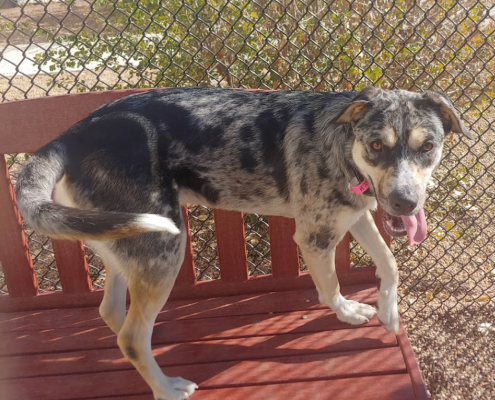
Dog’s tail is neutral (level with the spine) and moving back and forth in wide, loose, sweeping movements. He’s a happy camper!
Dogs displaying circular or sweeping tail wags will often also have soft eyes, loose, wiggly bodies, lolling tongues, wide smiley mouths and bouncy, exaggerated movements. These are all green light behaviors.
Tucked Tail
A tucked tail is a universally recognized symbol of fear in dogs. The degree of the tuck corresponds to the level of negative emotion, with a fully tucked tail expressing the highest levels of fear, anxiety and stress.
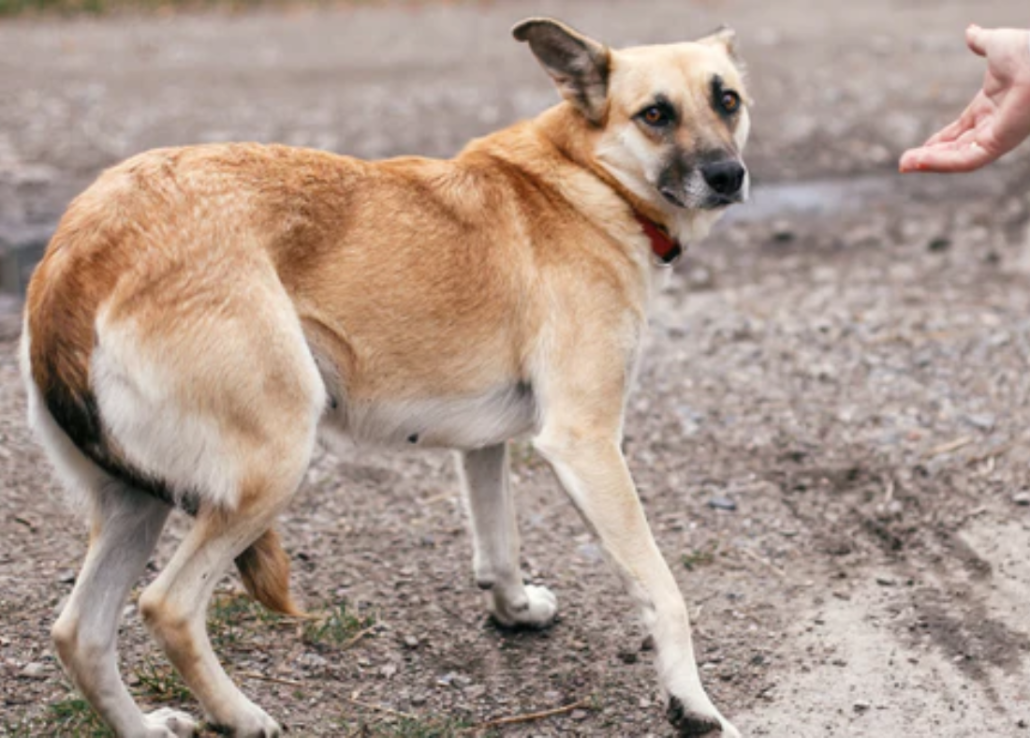
This dog has a tucked tail, round and wide eyes, and is leaning away from the hand extended to her.
Partially or fully tucked tails are often accompanied by tense, frozen bodies, pinned back ears, wide round eyes, furrowed brow, whale or side eye, weight shifted back and a closed mouth. These are clear yellow light behaviors (sometimes red) that say, “I am very uncomfortable/scared/stressed, please don’t come any closer.”
Flagged Tail
A stiff, high flagged tail with fast, tight wags is commonly a display of aggression. A high tail can also indicate high levels of arousal or alertness.
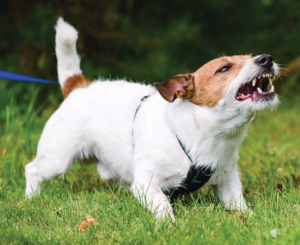
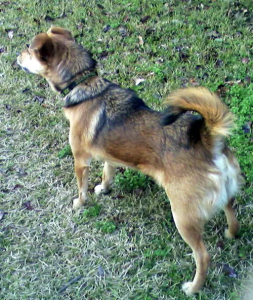
Both of the dogs pictured above have high, flagged tails. Their weight is shifted forward and their gaze is fixated and hard. High, flagging tails are often accompanied by stiff, frozen bodies, weight shifted forward, a direct, hard gaze, and piloerection. This can be a yellow or red light signal depending on context and the rest of the dog’s body language.
Mouths
Depending on context and other subtleties of behavior, a panting dog could be utterly relaxed, scared, or completely stressed out. The same is true about a dog with a closed mouth, or bared teeth. The position, shape, and tension surrounding a dog’s mouth can tell us a lot about their inner emotional state.
Panting
There is a distinct difference between happy, relaxed panting and stress panting. The former is often accompanied by a lolling tongue, soft eyes and a smooth, wrinkle free face. On the other hand, a stress pant can be identified by a tense, spatula-shaped tongue, a severely pulled back, v-shaped commissure (corners of the mouth), facial tension, dilated pupils, and excessive drooling.
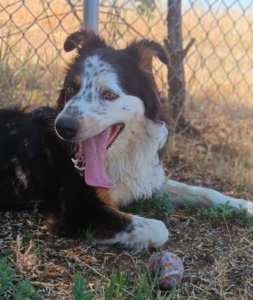
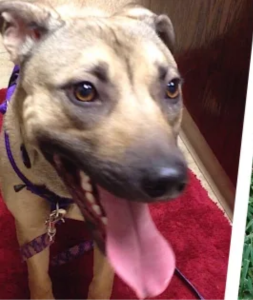
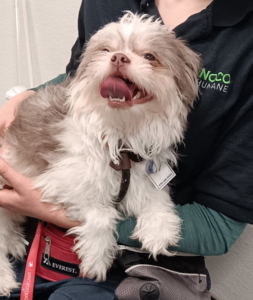
The dog on the top left is relaxed and content. She has a lolling tongue, neutral body, soft eyes, and no facial tension. The other two dogs (top right and bottom) may look content as well, but they are actually stressed out. Their ears are pinned back and they are both stress panting, which is often characterized by a spatulate tongue (tense and shaped like a spatula), facial wrinkles/tension, and a tightly pulled back and wrinkled commissure.
Closed Mouths
If you notice a dog panting, then quickly closes their mouth, pay attention! This is a strong red light behavior that often occurs just before a bite.
Lip Licking and Yawning
Dogs who feel uncomfortable, frightened, or stressed may lick their lips and/or yawn frequently. As always, context matters. These behaviors would mean something completely different if a dog had just woken up from a nap or eaten a spoonful of peanut butter!
There are many things to observe about a dog’s mouth that can help you determine how they may be feeling. Look for tension and/or wrinkles on the muzzle or surrounding the corners of the mouth, and pay attention to excessive lip licking, drooling, and yawning. Dogs who are stress panting may also show other signs of distress such as a tense body, pinned back ears, dilated pupils, and a tucked tail.
Teeth Baring vs. Submissive Grin
People often mistake what is called a “submissive smile or grin” for a snarly display of aggression. However, a submissive grin communicates the exact opposite of aggression. Dogs who grin or smile submissively are trying to say “I mean you no harm. I am no threat, please don’t hurt me.” A dog who is baring teeth out of aggression is communicating something entirely different, “I am not happy. Don’t come any closer, or I may have to do something about it!”


The two dogs above are displaying submissive grins. The dog below is snarling and baring his teeth – a warning to stay away!
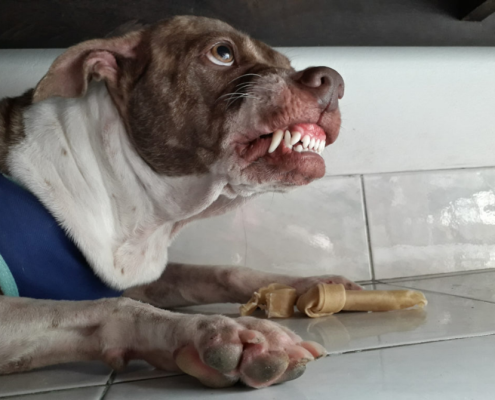
The best way to tell the difference between a submissive smile and an aggressive snarl is by looking at the rest of the dog’s body. Submissive grins are often accompanied by squinted eyes, a low wagging tail, submissive urination, curving the body and/or exposing the belly. An aggressive snarl is often paired with a stiff, rigid body, a hard glassy stare, a low growling.
Ears
Dogs come in all shapes and sizes, and the type of ears they have varies widely based on their breed and whether they are cropped or not.
Relaxed/Neutral
A dog’s neutral ear position will depend on their anatomy and what is “natural for them.” Relaxed or neutral ears are flexible and soft.
Pinned Back
Ears that lay flat against the head are a strong indication of fear, anxiety, and/or stress. On dogs with long, floppy ears, you can often tell they are stressed or frightened because they will pinch in their ear flaps.
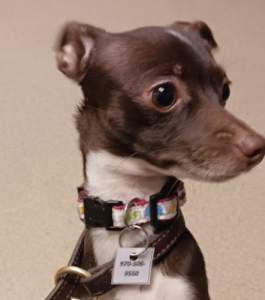
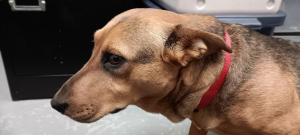
With their ears pinned against the sides of their heads, the dogs pictured above appear stressed and frightened. Beyond their pinned ears, they look tense, have tightly closed mouths, dilated pupils, and are giving side eye. These are yellow light signs.
Putting it All Together
When meeting, playing with, or in just in everyday living, pay attention to these subtle signs that show what your pet is feeling, and share what you see with family members, kids, and friends. This helps all of you recognize when your pets are comfortable and safe, or when they need more space. Thank you for reading! Your newfound knowledge will ultimately support the furry friends in our community and the people who love them.
More Resources on Dog Behavior
Dog bite prevention:
https://www.aspca.org/pet-care/dog-care/dog-bite-prevention
https://www.avma.org/resources-tools/pet-owners/dog-bite-prevention
In Spanish: https://kidshealth.org/es/parents/dog-bites.html
Further reading:
“Positive Training for Aggressive and Reactive Dogs” by Annie Phenix
“For the Love of a Dog” by Patricia B. McConnell, PhD, CAAB
“The Other End of the Leash” by Patricia B. McConnell, PhD, CAAB
“The Cautious Canine; How to Help Dogs Conquer Their Fears” by Patricia B. McConnell, PhD, CAAB

